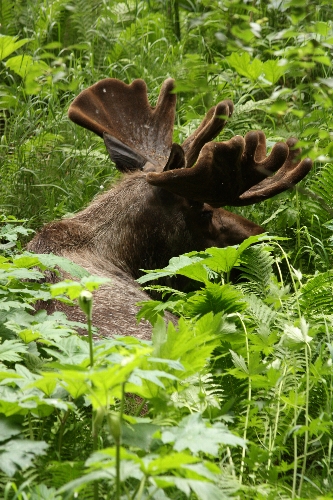Past and Current Studies
As the moose population in the Adirondacks stabilizes, various wildlife agencies and scientists have expanded upon their current and past knowledge of moose populations through scientific studies. Most of moose population data comes from public observation, a method that provides more information than scientific studies because sightings are reported on a constant basis in numerous locations. However, this information is harder to piece together. In 2009, Catherine Haase created a public moose observation database for the Adirondack State Park in an attempt to organize the locations of moose sightings. Haase began with historic moose data (1980 to 2009) obtained from the NYS Department of Environmental Conservation, the NYS Department of Transportation and the Wildlife Conservation Society's Adirondack Wildlife Watch. She then plotted the longitude and latitude of the sightings in order to see the distribution of these species across the park. Haase also developed a website to expand upon mapping of moose locations. On this observation report forum, information can be included such as the time, location, number of moose, sex of moose, age of moose, number and color of a possible ear tag (Haase 3).
Scientists have also sought to understand the genealogy of these populations. Present moose population sizes are a result of a stable breeding population, but the initial reestablished moose population was not native to the Adirondacks because they migrated from the north. In 2012, the Wildlife Conservation Society conducted a study to better trace the genealogy of the moose that have moved into the Adirondacks from Vermont and Canada since the late 1900s. Scientists sent out dogs to find moose scat, which was then used to genetically determine relationships between Adirondack colonies and other northern colonies (Lynch 2).
Despite the various methods by which scientists have pieced together information about moose colonies, there has never been a systematic study to get a complete reading on the moose population in the Adirondacks. The current population estimate is based solely on sightings, road kill and aerial surveys. Cornell University biologist Ed Reed plans to conduct a study of moose in the Adirondacks specifically aimed at getting a better estimate of their population. The plan for this study comes as a result of moose die-off observed in Minnesota and New Hampshire. Scientists believe that these deaths are a result of ticks, which can "gang up" on a single moose, bleeding the animal to death (Iacurci 6). This pest problem may become even more prevalent as winters grow shorter, allowing tick populations to flourish in warmer weather. With these dropping numbers in mind, Reed and other Cornell University biologists want to keep a close watch on the Adirondack moose population. The project is currently under way and is estimated to take around three years. Methods for the recount are extensive, including aerial-helicopter counts, DNA evidence from moose scat, and GPS satellite data from tracking collars. Scientists hope that this project will shed light on potential threats to moose in the Adirondacks and allow for a proactive conservation plan.
_______________________________________________________________________________________________________
Sources Cited
"Bull moose along Soda Butte Creek." Flickr. Yahoo, 26 Dec. 2013. Web. 11 May 2015.
"Eagle River Nature Center." Flickr. Yahoo, 24 June 2010. Web. 11 May 2015.
Haase, Catherine. Creating a Public Moose Observation Database for the Adirondack State Park. N.p.: n.p., 2009. Print.
Iacurci, Jenna. "Moose Die-Offs Prompt Population Count in the Adirondacks." Nature World News. N.p., n.d. Web. 5 Apr. 2015.
Lynch, Mike. "Moose Genealogy." Adirondack Daily Enterprise. N.p., 21 Apr. 2012.
Web. 12 May 2015.

